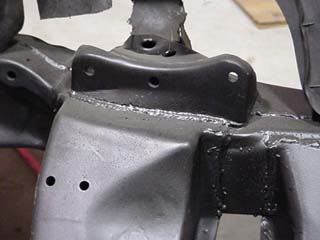 RELOCATED
UPPER MOUNT
RELOCATED
UPPER MOUNT
If you don't corner your Camaro hard, I doubt you need to do this modification. You can get a lot of improvement by changing springs, shocks, swaybar, bushings, tires and more aggressive alignment. If you have done all of these and still are wanting more cornering power, then consider doing it. The wider the tire you run the more it will help.
Another way to do it is to cut 3/4" off the bottom of the mount and re weld it to the frame about a half inch (my best guess if you need a better number, call Guldstrand) to the rear to increase caster, and reduce the thickness of the alignment shims. The upper A frame usually has an interference problem with the header pipes on the rear bushing (RH side).
It's interesting to note the Mustang guys are doing the "Shelby mod"! It's the same kind of mofification but for the Mustang!
 RELOCATED
UPPER MOUNT
RELOCATED
UPPER MOUNTThis is an upper mount that has been cut off, trimmed on the bottom, and re welded slightly to the rear.
You can see that if you were to drill the rear lower A arm mounting hole according to the Guldstrand template, you will have a problem with the rear shim hitting the angle change in the bracket and preventing proper seating of the shaft. You must trim the first alignment shim to prevent a problem.
Detroit Speed sells a really neat tubular upper A frame that uses a varation of the Guldstrand mod. I understand this upper A frame has slightly different dimensions from stock (shorter requiring less shims) and will allow setting more positive caster. Detroit Speed uses frame mounting holes in a slightly different location than the Guldstrand mod.
If you are planning on using these A frames, don't do the Guldstrand mod. Order the kit, and drill the holes as instructed by DSE.
I don't like these as far as streingth, possible 14" and 15" wheel clearance problems with the upper A frames, it raises the roll center too high causing excessive camber change and resulting side scrub on the tires. They raise the upper A frame 1 15/16" and that's too much unless you have a specific problem you are addressing.
I have been in contact with several people who removed them because they were wearing out the front tires.
The drop spindle kits use second gen parts, on a cast iron spindle similar to a second gen spindle with caliper mount cast in. The steering arm is two inches lower than a stock Camaro and the caliper mounts two inches higher in relation to the upper A frame, which can cause caliper to A frame clearance problems.
Several problems develop when you use drop spindles.
You can't fit some wide tires, the tie rod end winds up two inches lower in relation to the wheel so forget wide front rims.
Geometry stays stock which is not good on a Camaro.
Just trimming the springs to lower the car will put the geometry in a slightly better position as far as camber gain.
You may have clearance problems with the upper ball joint to caliper.
You can't use any aftermarket disc upgrades, they won't fit.
Steering arms are cast in, so you can't bend them to fix bumpsteer. You would have to use a rod end and spacers on a stud.
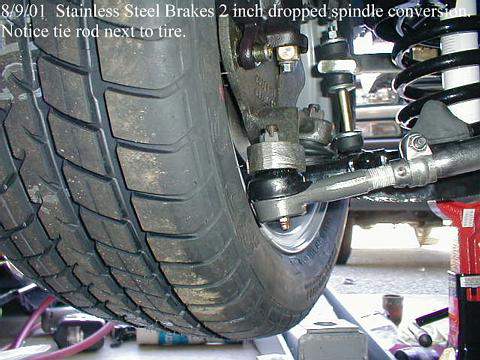
I have to apologize for using this photo. I took it from a web page of someone I exchanged E-Mails a fiew years ago. I can't find the E-Mail or web page or I would just provide a link to his page. I think this is the only image on my page that I don't have the owners permission to use. I feel the photo shows the problem so well, that I'll leave it here for a while.
I have a matching photo with the same wheel and tire but on a stock spindle, the tie rod end is two inches higher with that combination.
Another point, this is a Stainless Steel Brakes drop spindle, I don't know if other drop spindles are better or worse than this one. I don't know if Superior spindles makes all the drop spindles or if they are all making their own. If your 17" wheels have 4.25" backspace or less, they should clear, with "drop" spindles, according to posts on Team Camaro forum.
New drop spindles are being produced by Heidt, Fatman, and others. They are taller by 1.5" and correct the poor camber gain curve. However they are still drop spindles and still put the outer tie rod end in contact with the tire sidewall. If they were just taller it would be great.
"Bump Steer" refers to an incompatability between the steering linkage and a cars A frames.
The A frames and their relative relationship control the camber curve of the front wheels.
The lower A frame is usually level or close to it. The upper A frame is usually inclined down toward the center of the car a couple of degrees.
As the car goes into bump (frame gets lower) as when braking hard on corner entry. You want the tires to steer straight ahead. Many Camaros have toe out under bump. I have seen as much as 1" of toe out at three inches of bump travel. This will make the car dart left and right under hard braking.
When the car is leaning in a corner, one side is experiencing bump (down, the loaded side), the other is in rebound (up, the unloaded side). If you have a lot of toe out bump steer, the car will steer itself out of the turn. The inside tire will steer out of the turn due to additional toe IN, the outside loaded tire will experience toe OUT, turning out of the turn.
The fix is to get the steering linkage to travel the same arc as the spindle. On an early Camaro you MAY need to bend the steering arm (bend template) down or raise the inner mounting point. Here is a handy FORM you can use to fill in the needed dimensions to properly draw out your car's suspension.
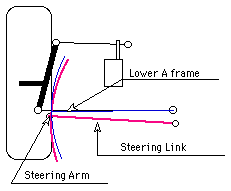
Click here for a link to more info on front suspension geometry.
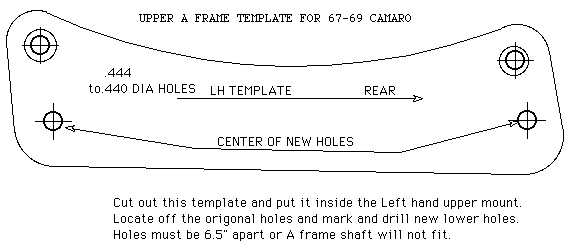
My measurements off my template are lower ft bolt 1.060" lower rear bolt .775" To measure, draw a line through the top hole centers, the cross hairs are accurate reference points, the circles are a bit off center so don't use them. Measure down from this line. The lower holes are also offset 1/4" to the rear to increase positive caster adjustment. My template was aquired by me when I visited Guldstrand sometime arond 1973, I talked to an engineer there who said they developed this template for Penske. My version shows some alternate holes that were tried, these holes were higher and lower than this "final" version.
All I can say is, I used the top measurements and they worked well on my 67 Camaro & the trend these days is to have even more camber gain, not less.
This is the template, "the Guldstrand Mod" that is used to improve the front suspension geometry. The Camaro front susupension has too low a front roll center, and almost no negaitve camber gain in bump. If you do this modification to your Camaro, make shure you trim the bottom of the first thick alignment shim you place on the rear bolt. The A frame mount face changes angle and the shim will hit and prevent the upper shaft from properly seating on the mount.
In addition, if you use stock upper A arms, the upper part of the mount must be trimmed off to about the height of the holes to allow enough clearance. The mount braces will also need to be trimmed or the A arm will hit in the middle.
If you use tubular upper A arms, the mount does not need to be trimmed near the holes, the braces may, or may not, not need trimming.
If you call Guldstrand ent, they will send you a template. Always verify the holes are 6.5" apart or the A arm will not fit.
To my eye these charts are upside down, but my chart software won't do it any other way, and I haven't had time to figure out how to reverse it.
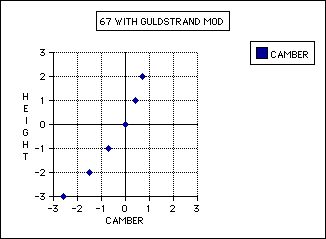
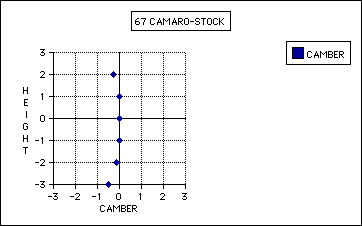
|
Measured from my 67 HEIGHT CAMBER -3" ...............-2.6 (bump, with springs compressed) -2" ...............-1.5 -1" ................-.7 0" .................0 NR (Normal Ride height-for a lowered car) +1" ............+.4 +2" ............+.7 (rebound, with springs extended) +3"............. NA |
HEIGHT CAMBER -3"...............NA -2".............-2.375 bump compressed -1".............-1. 0"..............-0 +1".............+1 +2".............+1.75 rebound Their figures start at .75 deg neg camber, I subtracted that amount to start out at zero deg. |
Please understand that you can't focus ONLY on camber gain.
As they say, a little knowledge is dangerous, and in the case of suspension geometry I feel it's VERY true. If you are going to change anything from stock, it's a good idea to understand all the ramifications of your "improvements". Since most everything concerning your suspension is interelated, one change usually affects other aspects of your suspension.
Changing upper A frame mounting location will change:
The roll center height affects driver feel, roll stiffness, how much of the cornering roll torque is fed through the springs, shocks, sway bars, vs how much is fed directly via the geometry to the tire.
EXTREME EXAMPLE: If the roll center were raised to the same height as the center of gravity, NO roll torque would be fed through the suspension at all! The car would not be tuneable by changing sway bars or springs!
SO lowering the upper A frame usually will raise the front roll
center, increase the neg camber gain, increase tire side scrub, the
higher roll center will move more - the more you lower the upper A
frame mount. If it get's too high, the tires will tend to break loose
if small bumps or undulations are hit in a corner.
The starting point should be the tires, and what they require
for best performance. Some tires need more negative camber than
others. Wider tires are more sensitive to camber changes.
You should temper tire requirements with the application, street, track, drag, roadrace, autocross, type of track, type of pavement, banking, bumps, etc.
They all have specific requirements from geometry to setup, and how much wear can be tolerated. I assume you would be concerned if your front tires wore out the inside edge in 500 miles?
You would then set up your suspension geometry, springs, swaybars, shocks, alignment, to best work with "that" tire.
The Guldstrand mod lowers the upper mount about just under an inch.
It retains low tire side scrub, stable roll center movement and
height, some beneficial negative camber gain. Still not as much gain as modern cars use.
Consider that my 89 IROC camaro had 1/2 to 3/4 degree static neg camber with the adjsters moved all the way in. The McPherson strut suspension added little in negative camber gain during roll.
Modern thinking is .7 degrees neg camber gain per inch is close to ideal.
More negative camber gain might be better, but it could easily be
worse in other areas.
You brake hard at the end of a long straightaway, now the tires are unevenly loaded on the inside edge during straight ahead braking! Result-poor braking, wheel locking.
Example two, you brake hard and turn into a corner, - all is good, you then get past the middle of the corner, get on the gas, the front end raises up under acceleration, now the camber curve goes the other way! The tire will lean out more. Your increased neg camber curve cranks camber out of the outside front tire, is that good? Result- corner exit understeer.
You enter a long high speed sweeper, the car is under power, front lifts a bit higher than static ride height due to power applied and aero lift. BUT you need to corner hard, you are on a flat curve going 90mph. How much negative camber did you lose? how much understeer are you going to have?
The best I can say is "dont' get greedy", people do break the rules sometimes, I've seen some crazy stuff work and win, especially on a circle track sprint type car. Those guys have some wierd ideas! But, circle tracks do not have flat or off-camber corners.
Large amounts of positive caster can work wonders and lessen the
need for lots of negative camber gain. That's what the late model
Corvettes and others do.
The Guldstrand mod increases negative camber gain, when the car leans (rolls) in a turn, the tire will not lean out as much as it does with stock geometry. It will also raise the front roll center making it more compatable with the rear roll center height.
Stock upper A arms can achieve around 3 degrees positive caster. "Properly" made Tubular upper arms allow higher positive caster alginment settings with pretty close to the same amount of shims front and rear. Increased positive caster from tubular upper arms can eleminate the tire leaning out when turning sharply. Steering effort will increase, but if you have power steering it won't matter. There are also dynamic weight jacking effects from high caster.
Park your Camaro on level ground and turn the wheels to the right to full lock, the left front tire will lean outward, (positive camber) by about 3 to 4 degrees, increased positive caster of around 5 degrees will keep the tire vertical. Remember the chassis will dive and roll in a turn and you need excess neg camber gain to make up for that.
A First Gen Camaro has 8.75 degrees steering axis inclination* (SAI) built into it, If you were able to turn the front wheels sharper to a 90 deg turn, the wheels would camber out by 8.75 degrees, minus any positive caster you have set. You can't turn your front wheels that sharply, but you can turn them around 26 degrees, which is almost 30% of 90 degrees.
In general, more neg camber gain via the Guldstrand mod will help most on large sweeper type corners, - generally high speed turns.
The tubular upper arms will allow 5 degrees positive caster with minimum shim stack which isn't achieveable with stock arms, usually 3 deg + is all you can get. Large amounts of caster tends to help most when the wheels are turned very sharply, like at an autocross, but it does help a bit on larger radius turns. The nice thing about positive caster is, it goes away when you point the wheels straight ahead, so you can use less neg camber setting
* SAI, Steering Axis Inclination, draw a line from top balljoint to bottom balljoint this is the rotation axis of the front wheel, a First Gen Camaro SAI is 8.75 deg from vertical with the top balljoint closer to the center of the car than the lower.
Caster and Camber settings
Using a lot of positive caster will help keep the tire flat on very sharp turns. The Camaro spindle has 8.75 degrees angle between the balljoints and wheel hub. If you could turn the front wheels 90 degrees, this would make the front wheel lean out that amount minus whatever positive caster you have set. Of course you can't turn the front wheels 90 degrees, but you can turn about half of that, and the tire will lean out by 4.375 deg. Try turning your wheels full lock and measure your camber or put a level up against the wheel to see which way it tilts.
On wide sweepers it would have much less benefit, but some.
More positive caster will take more steering effort so PS would help.
5 degrees positive is a good goal for street driving. For Autocrossers, I'd use 7 deg positive if you can achieve it. Many new cars like the Vette and Viper use 8 or 9 degrees positive caster. Mercedes uses 14 degrees positive caster.
I have a highly respected suspension book that recomends .1 degree toe OUT reduction, for every 1 degree neg camber you use.
.1 degree is almost 1/8 INCH toe out! This is total toe-out across the car, 1/16" per wheel.
Why? -
The front wheels try to turn inward when using neg camber due to "camber thrust".
Imagine the tire tilted one degree in at the top. As it rolls, the wheel will try to run around in a circle - Imagine it were on a bycicle and you were leaning it 1 degree.
Both front wheels cancel each other out, so the car stays
straight, but the tires are thrusting inward as you drive causing
scrub, and should
be toed out slightly to compensate for any "extra" neg camber you add.
Toe out also helps turn-in and may help Ackerman correction for tight
turns.
Original factory specs for 60's cars were developed for use with positive camber and bias ply tires required more toe in than radial tires do.
When radial tires came out, toe-in specs were reduced by half, so
a Camaro with a 1/8" plus toe in spec was reduced to 1/16" toe in. Many
front end shops may have forgotten this fact and set toe to the
"book". The first gen Camaro does have a high amount of bump steer
which makes the tires toe out when braking, so if you haven't corrected
bump steer, then maintain a good amount of toe in.